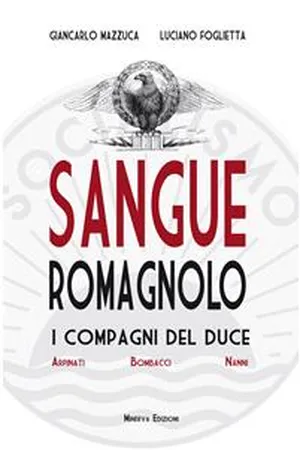
Sangue romagnolo. I compagni del Duce Arpinati Bombacci Nanni
- English
- ePUB (mobile friendly)
- Available on iOS & Android
Sangue romagnolo. I compagni del Duce Arpinati Bombacci Nanni
About this book
In un fazzoletto di terra, pochi chilometri quadrati, nell'aspra e solatia Romagna, sono nati e vissuti, in una manciata d'anni, a cavallo tra l'800 e il '900, quattro personaggi che hanno cambiato la storia d'Italia. Quattro uomini che, nel bene e nel male, hanno cercato di cullare un sogno: la speranza di cambiare la misera realtà in cui erano nati, l'orgoglio di vivere una vita degna di essere vissuta e di realizzare, con le proprie forze, un mondo diverso, forse perfetto, così distante dalla povera e cara terra, la Romagna, che hanno continuato ad amare per tutta la vita. Benito Mussolini, Nicola Bombacci, Leandro Arpinati e Torquato Nanni, amici-nemici da sempre, potevano nascere solo nella Romagna di quegli anni, dove per dirla con le parole di Torquato, il vero intellettuale dei quattro, "la politica non è interesse e non è dottrinarismo: è azione, è passione, è ribellione". La loro vita sembra un romanzo: abbracciarono, nella loro gioventù, la causa socialista, ma poi, negli anni dell'interventismo, le loro strade si divisero e, dopo la Grande Guerra, le camicie nere di Mussolini deridevano Bombacci, che era allievo di Lenin e aveva fondato a Livorno il Partito Comunista d'Italia, cantando: "Con la barba di Bombacci faremo spazzolini per lucidare le scarpe a Mussolini!". Arpinati, a sua volta, era diventato Podestà di Bologna, mentre Nanni non abbandonò la causa socialista. Lottarono su fronti politici opposti, ma restarono amici per la pelle: se il Duce aiutò (in segreto) economicamente il comunista Bombacci, il fascista Arpinati salvò il socialista Nanni che stava per essere linciato dai camerati fiorentini. Poi il drammatico epilogo del 1945: Bombacci morì accanto a Mussolini, a Dongo, e Nanni fu ucciso dai partigiani nel tentativo di salvare Arpinati a Malacappa una frazione del Comune bolognese di Argelato.
Divisi nella vita, uniti nella morte.
Frequently asked questions
- Essential is ideal for learners and professionals who enjoy exploring a wide range of subjects. Access the Essential Library with 800,000+ trusted titles and best-sellers across business, personal growth, and the humanities. Includes unlimited reading time and Standard Read Aloud voice.
- Complete: Perfect for advanced learners and researchers needing full, unrestricted access. Unlock 1.4M+ books across hundreds of subjects, including academic and specialized titles. The Complete Plan also includes advanced features like Premium Read Aloud and Research Assistant.
Please note we cannot support devices running on iOS 13 and Android 7 or earlier. Learn more about using the app.
Information
Table of contents
- Copertina
- Colophon
- Indice
- Prefazione di Sergio Zavoli
- Sangue romagnolo nota autori
- Premessa
- Parte Prima - Le strane coppie
- Parte Seconda - Mussolini-Bombacci
- Parte Terza - Nanni-Arpinati
- Epilogo
- Bibliografia
- Ringraziamenti